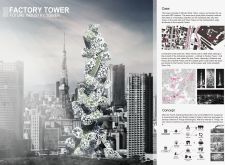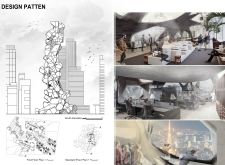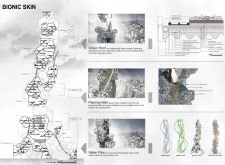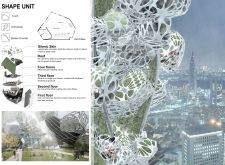5 key facts about this project
FACTORY TOWER presents a vertical mixed-use tower that redefines urban living by merging community, ecology, and flexible architecture. Designed as a contemporary cohabitation model, it integrates housing, retail, and shared facilities within a form shaped by renewable materials and biophilic design principles.
Materiality and Structure
The building employs cross-laminated timber panels as primary structural elements, supplemented by charred timber shingles that enhance durability and weather resistance while giving the facade a textured, organic character. A bent A-frame geometry supports the tower’s structural integrity, while glass and steel elements provide contrast, transparency, and openness.
Spatial Strategy
Large, strategically placed windows maximize daylight penetration and frame views of the surrounding city, reducing reliance on artificial lighting. Flexible floor layouts allow for residential, commercial, and communal uses to coexist, with open-plan interiors adaptable to shifting needs. This design flexibility reflects contemporary demands for multifunctional urban spaces.
Biophilic Integration
Vertical green walls and rooftop gardens establish a direct relationship between architecture and ecology. These natural elements improve air quality, promote biodiversity, and offer restorative green spaces for occupants. The integration of greenery also reduces heat gain and supports passive cooling, contributing to the building’s environmental performance.
Sustainability Features
Sustainability is embedded through the use of renewable and reclaimed materials, high-performance glazing systems, and energy-efficient mechanical solutions. Smart technologies further optimize building operations, reducing the overall carbon footprint and supporting long-term resilience.
Community and Shared Spaces
Beyond private residences and commercial areas, the project incorporates shared communal zones designed for adaptability. These spaces can host cultural events, neighborhood gatherings, or informal encounters, reinforcing social cohesion within the vertical community.






















































